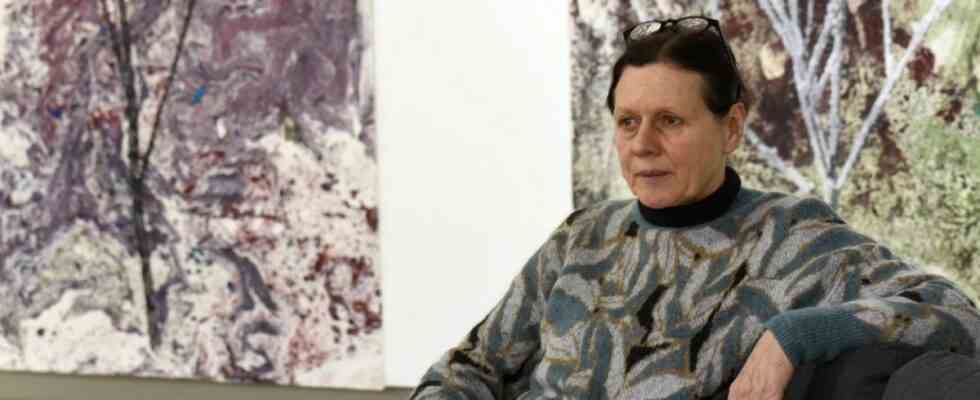Suddenly you are standing in the middle of a painting by Mane Hellenthal, in a huge, snow-covered forest of crooked little trees. A dream landscape in which contours disappear and suggested schemes appear. In this thicket of trees and fine ramifications, it’s easy to lose your bearings. One almost overlooks it: Isn’t there a little human being standing there in the middle of the forest, which is a hundred times larger than him?
One could say a lot of abstract things about the relationship between nature and man. Above all, however, it is a feeling that overcomes the viewer: a hunch that he is just a tiny speck in a vast universe, a driftwood with consciousness that time will irretrievably swallow. Is that reality he thought he was actually supporting him?
Those who are willing to expose themselves to the danger of seeing a little bit of reality are advised to visit the KVD gallery until March 26th. The exhibition “Finisterre” by the Saarland artist Mane Hellenthal can be seen there.
Crooked trees, and somewhere, small and easily overlooked, stands the human being.
(Photo: Toni Heigl)
Finisterre? The title of the exhibition initially seems to refer to a specific location. Perhaps the legendary end of the Way of St. James in France, where the Atlantic thunders towards rugged, steep cliffs? Such places, where the landscape is forbidding and the conditions are inhospitable, are what Hellenthal has in mind. She is also interested in another aspect of the title, which comes from the Latin “Finis Terrae” – the end of the world. “There’s something poetic about the title. It’s also about the fear that the world will end,” Hellenthal explained at the vernissage of her exhibition.
It is striking that the artist does not look for poetry in such prominent places on the open, storm-torn sea. No, her gaze wanders inland, where the sensitive vegetation is exposed to the harshness of the conditions. Where nature is brute and vulnerable, barren and delicate in the same gust of wind.
A series of pictures in which she works with real slate is particularly striking. The rock is inhospitable and hard, black like a glimpse into the abyss of nothingness. Nevertheless, small, graceful plants dare to appear in liquid paint. They grow up so unprotected and vulnerable that you hold your breath to keep them from twisting.
Delicate little plants grow tentatively out of hard, black slate rock.
(Photo: Toni Heigl)
Hellenthal’s way into art was unusual. At the age of 20 she trained as a goldsmith and later worked as a dental technician. It is only later that she realizes that she cannot do the work to order. Your creative streak longs for freer forms of expression. At the age of 33, she began studying art in Saarbrücken, repeatedly receiving scholarships and over time developing a reputation that extended beyond the Saarland. Leipzig, Munich, Berlin, but also Austria and Luxembourg are some of the stations where her art has already been exhibited.
After decades of creation, the number of her works is in the thousands. Despite the diversity of her oeuvres, one theme can be identified that has accompanied her throughout her life: nature, in its vulnerability and brutality. Man is not always just the small, astonished dot that frugally submits to his fate.
In the exhibition in the KVD gallery, for example, you will also find paintings that strike a completely different note. A meticulously drawn, sharp-edged steel construction towers surreal in the valley floor of a snow-covered mountain massif. Man wants to rule. Apocalyptic mood of the end of time, as if civilization had long since passed into non-existence, but nature is struggling to recover from it.
Red spots waft through the mountains. “If you want to interpret it a bit melodramatic: the landscape is bleeding,” says Hellenthal. The technique of marbling, with which the artist created the “blood”, not only has something irrationally dreamlike about it that eludes consciousness, but also a further metaphorical dimension: Where exactly the liquefied paint flows to is a product of chance. Hellenthal provided the impetus, but she no longer had the effects under control.
Some of Mane Hellenthal’s paintings have an apocalyptic end-of-time atmosphere.
(Photo: Toni Heigl)
Where does the artist get her wealth of ideas from? “I encounter that,” she explains. “Sometimes I find striking flowers along the way, sometimes I unexpectedly come across strange architecture, sometimes I find a motif while leafing through the family album.” Many of her works are therefore replicas and alienations of what actually exists. “If I processed all the ideas, I would be busy for a long time, probably until the end of my life.”
But if you look closely, you will also discover indications of nature’s ability to defend itself in Hellental’s pictures. A glacier determined to swallow is already tearing at the foundations of the ominous steel construction. She gets into trouble. Who will we have been? The massif rumbles: Nothing.
Man – just an atavism of nature? Whatever the outcome, one thing is certain: as is well known, philosophy begins with amazement and with philosophy understanding of the world. Thanks to Hellenthal, the former found its way into the KVD gallery.
“Finisterre”, exhibition by Mane Hellenthal in the KVD gallery, Pfarrstraße 13. Opening hours Thursday to Saturday 4pm to 7pm and Sunday 2pm to 6pm. On view until March 26th.

